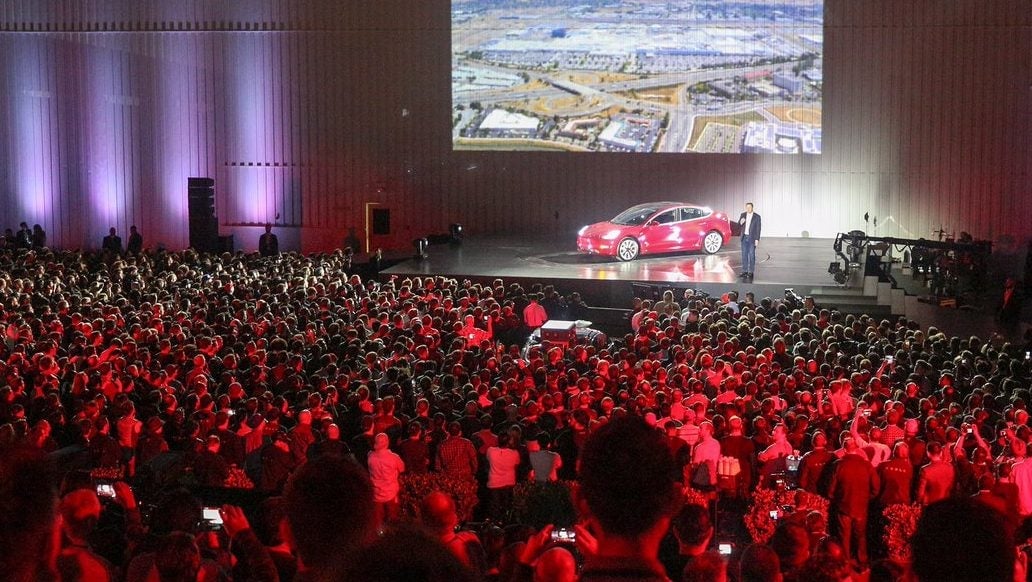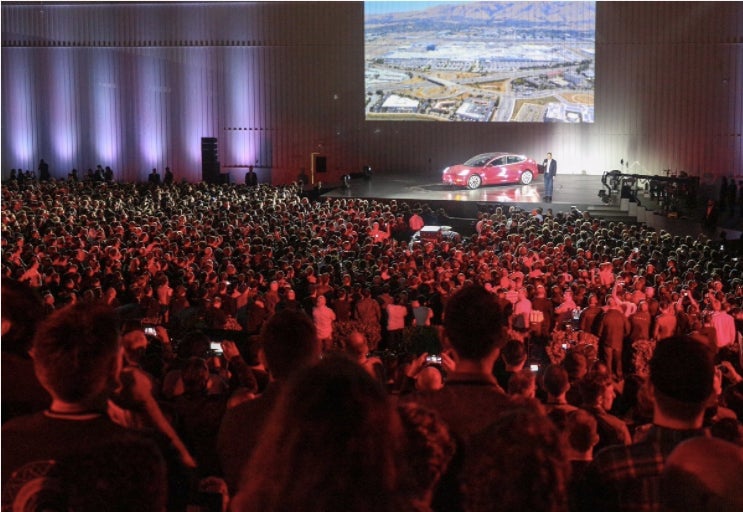Elon Musk delivers the first Model 3—and says Tesla’s about to enter “production hell”
The Model 3 is no longer just a car.


The Model 3 is no longer just a car.
Tesla’s first mass-market car is the literal and symbolic vehicle of its ambitions: a world driven by clean energy. For the 400,000 or so customers who plunked down $1,000 to be first in line, it’s a chance to buy a slice of that future and perhaps the sleekest 220-mile range electric vehicle on the market for around $35,000—the slightly pricer Chevy Bolt, while basking in reviewers’ praise, was never accused of sex appeal.
Thousands of Tesla customers, employees, and guests gathered the evening of July 28 at the company’s Fremont, California factory where Musk plans to build half a million EVs—400,000 of them Model 3 cars—next year. Like most of Tesla’s events, the Model 3 delivery featured a black-clad Elon Musk, who aside from being CEO embraces his role as chief electric evangelist. He drove on stage in a Model 3, exited the car a bit awkwardly, and began joking with the audience, delivering dry one-liners and self-deprecating asides, while 30 of the new cars sat charging nearby their awaiting new owners.


In a 20-minute talk, Musk described an effort to build a car that has monopolized the company’s focus for more than a year, and which will become even more of an obsession as Tesla tries to build more than 33,000 of them each month by next year. “Frankly, we’ll be in production hell,” he told the audience.
The first look at the Model 3 was impressive by EV standards—or even conventional cars. The standard model has a 220-mile range, five-seats, and can hit 131 miles per hour for a price equivalent to the median US car price. The $44,000 long-range version can travel 310 miles on a single charge.
Musk said Tesla is embracing a simple, minimalist design for expansive airy interiors, anticipating the day drivers will no long need to pay such close attention to their dashboards and the road ahead when automation fully arrives. Each car already comes kitted out with eight cameras, 12 ultrasonic sensors, and radar for self-driving if or when the software arrives.
As if to foreshadow the challenges to come, Musk mentioned the difficulties of assembling a car with 10,000 unique parts from a supply chain spread across the globe. Tesla will build them at a scale that eclipses everything the company has manufactured to date. “We’re driving the [production] ramp as fast as we can,” he said. Musk added the company will also triple the number of its supercharger stations across Europe, Australia, Asia, and North America, and touted a video showing the resilience of the Model 3 in a crash test compared with a Volvo S60.
The Model 3 is Tesla’s biggest bet to date. After a successful and unprecedented pre-sale, which racked up billions of dollars worth of pre-orders, Tesla has scrambled to prepare for unexpected demand. Rather than ease expectations, Musk doubled down on moving up his target for producing 400,000 Model 3 cars from 2020 to 2018.
But price is still a sticking point. US buyers of electric vehicles will receive a $7,500 tax credit (and some state incentives), although the number is limited to the first 200,000 EVs sold by each US carmaker. Once that threshold is crossed, incentives decline and then disappear entirely. Tesla’s base price of $35,000 also excludes many features owners may want, such as Autopilot ($5,000), glass roof and wood trim ($5,000), and full self-driving capability if released ($3,000), reports Wired.
Tesla, though, can sell to people’s desire while staying within many customers’ budgets for mid-priced cars. “Tesla is very much in that sweet spot in having an emotional response [from customers] and meeting practical needs,” said Rebecca Lindland, an automotive analyst for Kelley Blue Book.
Still, the forecast is uncertain for Tesla and the EV market generally. Gas prices are expected to stay low for the immediate future. Most Americans remain unaware that electric cars are readily available. Infrastructure for fast charging remains spotty outside major cities and highways. Not to mention, the Model 3’s closest counterpart, the Chevy Bolt, has not logged overwhelming sales. As of June, about 7,500 of them have been sold, and the Wall Street Journal reports (paywall) the GM factory manufacturing the $37,000 cars will pause over the summer in the midst of its nationwide rollout.
But the trend is clear. Economics will soon bring the total cost of ownership for electric vehicles (including maintenance, fuel, and operation) below that of internal combustion engines, reports Navigant Consulting. That timeline will likely be accelerated by governments, from California to Denmark, pushing to ban gasoline engines from the road as soon as possible to slow the pace of climate change.
The Model 3 appears to be one of the first vehicles to make that idea appealing to the masses.